
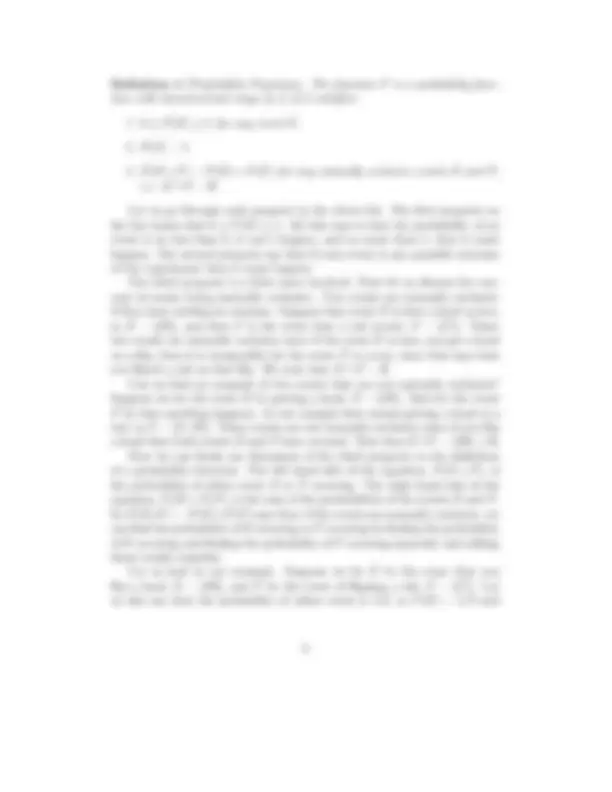
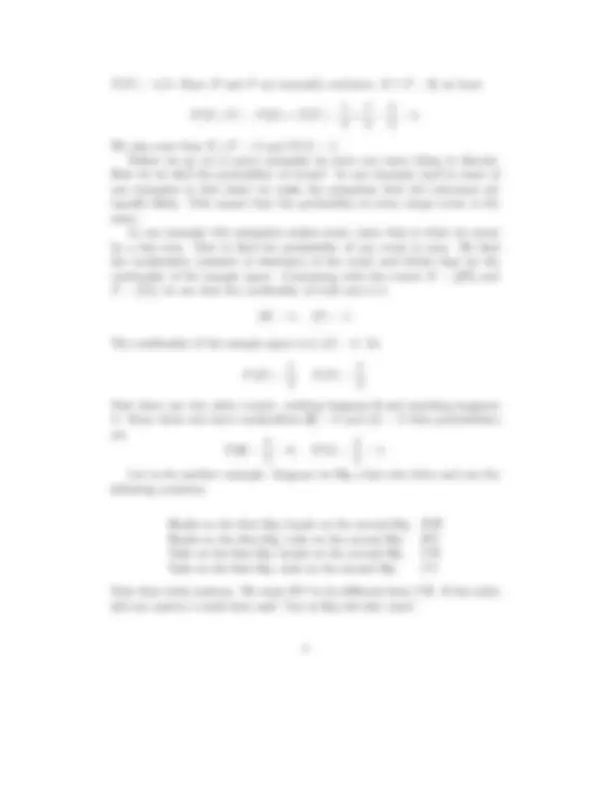
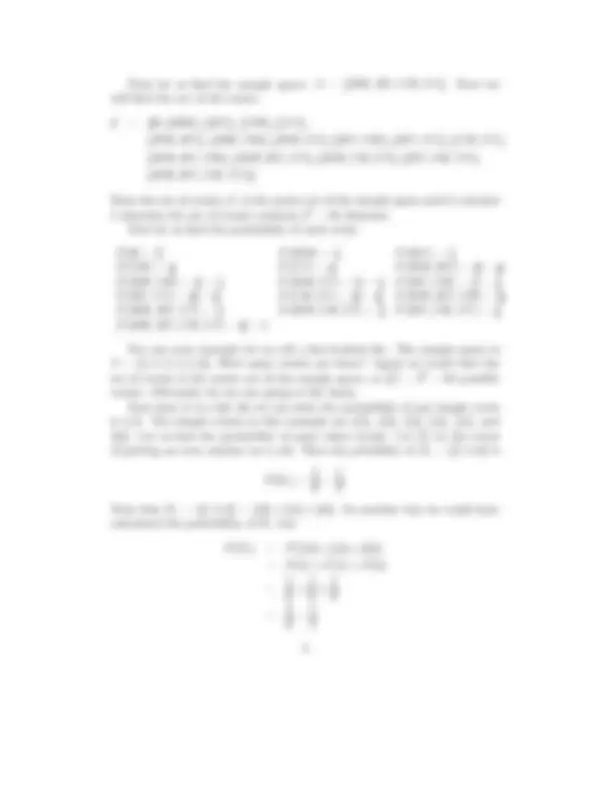
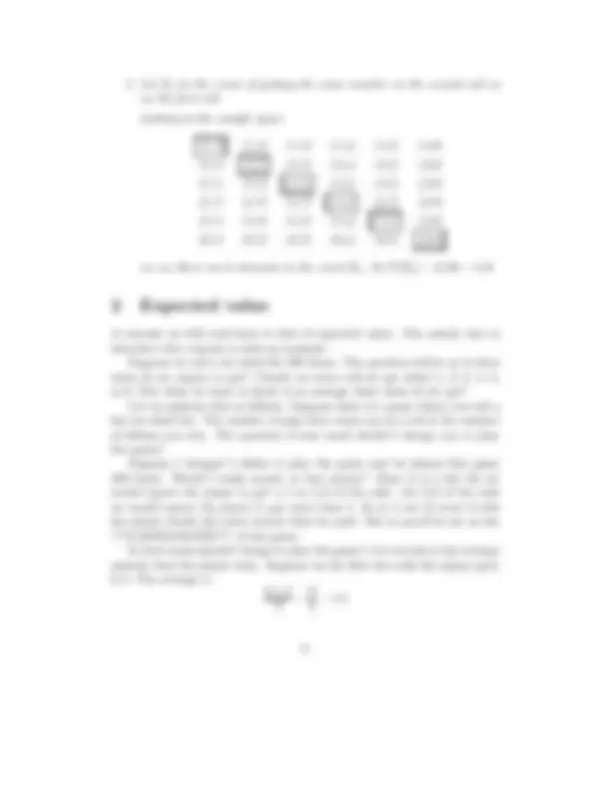
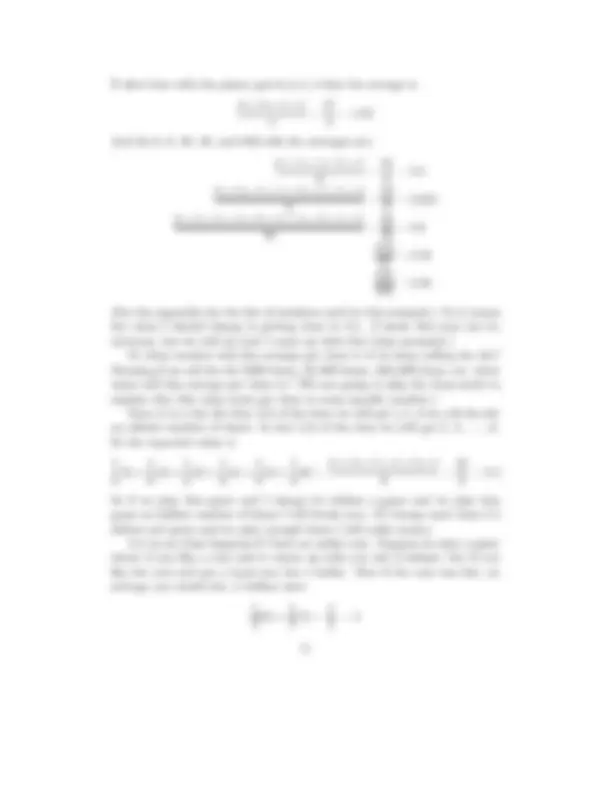
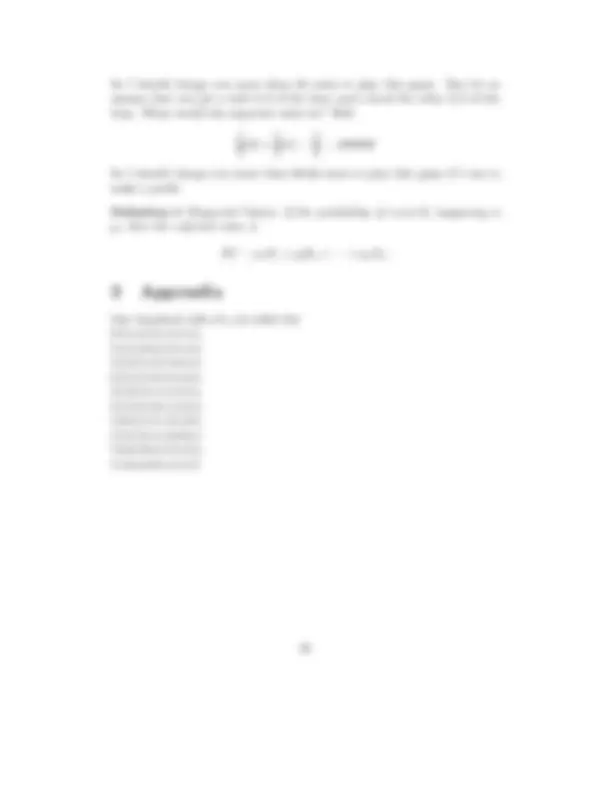


Study with the several resources on Docsity

Earn points by helping other students or get them with a premium plan


Prepare for your exams
Study with the several resources on Docsity

Earn points to download
Earn points by helping other students or get them with a premium plan
Community
Ask the community for help and clear up your study doubts
Discover the best universities in your country according to Docsity users
Free resources
Download our free guides on studying techniques, anxiety management strategies, and thesis advice from Docsity tutors
An introduction to probability theory, focusing on the concepts of sample spaces, events, and event probabilities. The basics of probability, including the frequency method, the concept of mutually exclusive events, and the properties of a probability function. It also includes examples and calculations of probability for various events in different contexts.
Typology: Study notes
1 / 10

This page cannot be seen from the preview
Don't miss anything!







Suppose we flip a fair coin. How often can we expect heads to come up? There are two ways of investigating this question. The first way is to use the frequency method. In this method we preform our experiment (flip the coin in our case) “many” times. Then we count the number of occurences of our desired outcome (in our case the number of times heads comes up) and divide that by the total number of times we preformed our experiment (number of flips of the coin). So let us say we fliped our coin 10 times and got the following result:
HHHT HT HHT T.
There are 6 heads. So the probability of getting a head seems to be approx- imately 6/10 = .6. What if we were to preform the experiment 20 times?
T HHT T T T T HHHHHHHT HT HH.
There are 12 heads so the probability is approximatly 12/20 = .6. How about 100 flips?
T T T T T T T HHHT HHHHHT HHT HHHT T HT HT HT HHHHHT HHT HT T HHT HHT HT T HT T T T HT T HHHT T HHHT T T T T T T HT HHT HT HHT HT HHT T HHT HT HT T T.
Now there are 50 heads so the probability is approximatly 50/100 = .5. Now we happen to know that this is the correct probability for getting a head when fliping a fair coin. But how do we know that if we flipped the coin 1000, 10000, or more times it would not get closer to say .53? There are ways, but we will not get into them. This technique is most useful when we do not know enough details about the process we are investigating or if it is infeasable to do a direct analysis of the process. In the case of a fair coin we do know enough (and it is easy enough) to do a direct analysis. This is the method we will concentrate on. As usual we need to start with some definitions. I will use the fair coin flipping example to give a concrete instance of each definition. Our first definition is that of a sample space.
Definition 1 (Sample Space). The sample space is the set of all possible outcomes of the experiment. We denote it by S.
So in our coin flipping experiment the sample space is
S = {T, H}.
The next concept is that of an event. An event is any thing that can happen during the experiment. There are two events (in our example) that are obvious: getting a head, H and getting a tail T. But there are two other events that are possible: nothing happens ∅ and all possible outcomes {T, H}.
Definition 2 (Event). An event is any element of the power set of the sample space. Let us denote the set of all events by E.
Our set of all events is
E = {∅, {T }, {H}, {T, H}}
It is useful to have a definition for events that contain only one outcome.
Definition 3 (Simple Event). A simple event is an outcome that has only one element
The final concept we need is that of a probability function. The idea of a probability function is that it assign to each event a number, between 0 and 1 or (recalling interval notation) a value in [0, 1], called the probability of that event.
P (F ) = 1/2. Since E and F are mutually exclusive, E ∩ F = ∅, we have
We also note that E ∪ F = S and P (S) = 1. Before we go on to more examples we have one more thing to discuss. How do we find the probability of events? In our example (and in most of our examples in this class) we make the assuption that the outcomes are equally likely. This means that the probability of every simpe event is the same. In our example this assuption makes sense, since that is what we mean by a fair coin. Now to find the probability of any event is easy. We find the cardiniality (number of elements) of the event and divide that by the cardinality of the sample space. Continuing with the events E = {H} and F = {T }, we see that the cardinality of both sets is 1:
|E| = 1, |F | = 1.
The cardinality of the sample space is 2, |S| = 2. So
Now there are two other events: nothing happens ∅ and anything happens S. Since these sets have cardinalities |∅| = 0 and |S| = 2 their probabilities are
P (∅) =
Let us do another example. Suppose we flip a fair coin twice and use the following notation:
Heads on the first flip, heads on the second flip HH Heads on the first flip, tails on the second flip HT Tails on the first flip, heads on the second flip T H Tails on the first flip, tails on the second flip T T
Note that order matters. We want HT to be different from T H. If the order did not matter I could have said “Let us flip two fair coins”.
First let us find the sample space: S = {HH, HT, T H, T T }. Next we will find the set of all events:
E = {∅, {HH}, {HT }, {T H}, {T T },
{HH, HT }, {HH, T H}, {HH, T T }, {HT, T H}, {HT, T T }, {T H, T T }, {HH, HT, T H}, {HH, HT, T T }, {HH, T H, T T }, {HT, T H, T T }, {HH, HT, T H, T T }}
Since the set of events, E, is the power set of the sample space and it contains 4 elements the set of events contains 2^4 = 16 elements. Now let us find the probability of each event.
P (∅) = 04 P (HH) = 14 P (HT ) = (^14) P (T H) = 14 P (T T ) = 14 P (HH, HT ) = 24 = (^12) P (HH, T H) = 24 = 12 P (HH, T T ) = 24 = 12 P (HT, T H) = 24 = (^12) P (HT, T T ) = 24 = 12 P (T H, T T ) = 24 = 12 P (HH, HT, T H) = (^34) P (HH, HT, T T ) = 34 P (HH, T H, T T ) = 34 P (HT, T H, T T ) = (^34) P (HH, HT, T H, T T ) = 44 = 1
For our next example let us roll a fair 6-sided die. The sample space is S = { 1 , 2 , 3 , 4 , 5 , 6 }. How many events are there? Again we recall that the set of events is the power set of the sample space, so |E| = 2^6 = 64 possible events. Obviously we are not going to list them. Now since it is a fair die we can state the probability of any simple event is 1/6. The simple events in this example are { 1 }, { 2 }, { 3 }, { 4 }, { 5 }, and { 6 }. Let us find the probability of some other events. Let E 1 be the event of getting an even number on a roll. Then the prbability of E 1 = { 2 , 4 , 6 } is
Note that E 1 = { 2 , 4 , 6 } = { 2 } ∪ { 4 } ∪ { 6 }. So another way we could have calculated the probability of E 1 was
P (E 1 ) = P ({ 2 } ∪ { 4 } ∪ { 6 }) = P (2) + P (4) + P (6)
=
Looking at the sample space
(1,1) (1,2) (1,3) (1,4) (1,5) (1,6) (2,1) (2,2) (2,3) (2,4) (2,5) (2,6) (3,1) (3,2) (3,3) (3,4) (3,5) (3,6) (4,1) (4,2) (4,3) (4,4) (4,5) (4,6) (5,1) (5,2) (5,3) (5,4) (5,5) (5,6) (6,1) (6,2) (6,3) (6,4) (6,5) (6,6)
we see there are 10 simple events with exactly one 1. So P (E 2 ) = 10 /36 = 5/ 18.
we see there are 6 elements in the event E 3. So P (E 3 ) = 6/36 = 1/ 6.
we see there are 9 elements in the event E 4. So P (E 4 ) = 9/36 = 1/ 4.
(1,1) (1,2) (1,3) (1,4) (1,5) (1,6) (2,1) (2,2) (2,3) (2,4) (2,5) (2,6) (3,1) (3,2) (3,3) (3,4) (3,5) (3,6) (4,1) (4,2) (4,3) (4,4) (4,5) (4,6) (5,1) (5,2) (5,3) (5,4) (5,5) (5,6) (6,1) (6,2) (6,3) (6,4) (6,5) (6,6)
we see there are 6 elements in the event E 5. So P (E 5 ) = 6/36 = 1/ 6.
2 Expected value
A concept we will need later is that of expected value. The easiest way to introduce this concept is with an example. Suppose we roll a six sided die 100 times. The question before us is what value do we expect to get? Clearly on every roll we get either 1, 2, 3, 4, 5, or 6. But what we want to know is on average what value do we get? Let us rephrase this as follows. Suppose there is a game where you roll a fair six sided die. The number of pips that comes up on a roll is the number of dollars you win. The question is how much should I charge you to play the game? Suppose I charged 1 dollar to play the game and we played this game 100 times. Would I make money or lose money? Since it is a fair die we would expect the player to get a 1 on 1/6 of the rolls. On 5/6 of the rolls we would expect the player to get more than 1. So in 5 out of every 6 rolls the player would win more money than he paid. Not to good for me as the ???GAMEMASTER??? of the game. So how much should I charge to play the game? Let us look at the average amount that the player wins. Suppose on the first two rolls the player gets: 6 , 3. The average is 6 + 3 2
So I should charge you more than 50 cents to play this game. But let us assume that you get a tails 1/3 of the time and a head the other 2/3 of the time. What would the expected value be? Well
1 3
So I should charge you more than 66.66 cents to play this game if I am to make a profit.
Definition 5 (Expected Value). If the probability of event Ei happening is pi, then the expected value is
EV = p 1 E 1 + p 2 E 2 + · · · + pnEn.
3 Appendix
One hundered rolls of a six sided die: 6,3,4,4,3,1,5,3,4,5, 3,4,5,2,6,2,2,1,4,2, 2,3,3,2,4,3,1,6,1,2, 6,2,5,1,2,3,3,4,2,2, 3,5,6,2,1,4,1,2,5,4, 6,2,3,2,1,6,1,1,6,3, 4,6,6,5,1,1,3,5,3,6, 2,3,2,2,1,4,3,6,6,4, 1,6,6,2,6,2,2,1,2,3, 1,5,6,5,6,6,4,5,5,